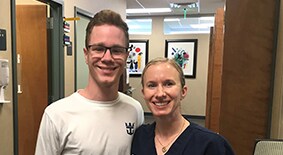Limb Lengthening Surgery
Limb lengthening surgery is a treatment for major limb length discrepancies (often greater than 2 inches) in a child’s bone. The reconstruction focuses on straightening the bone (if crooked) in addition to making it longer. There procedures can improve function and enable your child to walk without a large shoe lift or prosthesis.
Limb lengthening is a very specialized surgical skill, and only surgeons who are trained in limb lengthening should perform the operation. If the bone is lengthened too fast, it may not heal, and the surrounding muscles, nerves and joints may be at risk for permanent damage. If the bone is lengthened too slowly, it may heal too quickly, and the bone may not be able to reach its desired length. Our team in the Orthopedics Program at Children’s Healthcare of Atlanta understands how to properly lengthen bones in growing kids and teens.
There are two types of devices that our pediatric and deformity-trained orthopedic surgeons use during a limb lengthening surgery at Children’s:
What device will work best for my child?
Your child’s doctor will talk to you about the benefits of each device. In addition, your doctor may prescribe special orthotics (custom fit shoes, shoe lifts, braces and splints) as an option for your child.
What are the other surgery options?
Some other options for surgery may include:
- Lengthen or shorten fingers and smaller bones
- Straighten bones and fingers
- Amputation
- Reposition bones and fingers
- Transfer fingers and toes
- Targeted muscle innervation
- Amputation
There are many factors that affect how much a bone can be lengthened. It mostly depends on the underlying reason why the bone needs to be lengthened in the first place. Generally, a bone can safely be lengthened by 20%. For example, if a bone is 10 inches, it could safely be lengthened by 2 inches.
Prior to your child’s limb lengthening surgery, our surgeon will work with your family to determine a goal length for the bone. This goal may change depending on how the lengthening process is going. On average, an external fixator will remain in place for one month for every centimeter of lengthening. For example, if the goal is to lengthen your child’s limb by 5 centimeters (2 inches), the external fixator will need to stay on for five months.
Limb lengthening surgery is a big decision. This procedure takes a large commitment by you, your child and your surgeon. It’s important for everyone to be committed to the treatment and maintain communication.
There are risks with limb lengthening. Tightness around the hip, knee, and ankle are relatively common with lower extremity lengthening. While the bone is being lengthened, the skin, muscles and nerves must lengthen as well. At Children’s, we have developed a specific post-operative physical therapy protocol designed to decrease stiffness during lengthening. In addition, your surgeon may recommend you wear a brace at night to decrease the risk of joint tightness. Typically, once lengthening is complete, the range of motion of the joints improve.
The most serious risk is a joint dislocation. The knee or hip can dislocate during a lengthening procedure. Children with congenital (present at birth) femoral deficiency are at much higher risk for a joint dislocation. This can be prevented with weekly X-rays and intensive physical therapy to maintain range of motion. It’s important to work with your child’s care team. Your child’s doctor should also take care not to overlengthen the limb. Joint dislocations are rare and can be treated, but it is best to avoid them.
Your child’s doctor will talk to you about all of the risks involved with the surgery. Our surgical team takes many precautions to help ensure the safety of each patient. We have expertise in limb lengthening and an experienced comprehensive limb difference team to take care of your child.
-
Meet Dr. Flanagan
Jill C. Flanagan, MD, is the Co-Lead of the Comprehensive Limb Difference Program and a pediatric orthopedic surgeon at Children’s Healthcare of Atlanta.
Everyone has a different experience with pain during limb lengthening treatment. In general, the first inch added during treatment is relatively easy, but additional inches can be more painful for kids. Our team uses several ways to manage pain. Your child’s surgeon will work with you to create a pain management plan.
Strong pain medications are typically stopped within one week of surgery. Acetaminophen and ibuprofen may be used for a longer period of time. Distraction therapies are recommended to help ease fears or concerns before a procedure. This may include aromatherapy therapy or meditation for older patients, and video games or virtual reality techniques for younger patients.
While your child is undergoing limb lengthening treatment, your surgeon will typically see you on a weekly or biweekly basis to help ensure the limb is lengthening properly.
Your surgeon will give you very specific instructions on how to use your internal lengthening nails or external fixator device. It is very important to follow these instructions carefully. Adjusting the devices too fast or too slow can be dangerous and lead to complications.
Here are some questions we often get from caregivers:
Limb lengthening will only be successful if your child is able to continue to move his hip, knee and ankle during the lengthening process. If your child’s knee, hip or ankle are becoming too stiff, or if the joints are appearing to come out of place, your doctor will stop the lengthening process to avoid complications.
Your child should start physical therapy immediately after surgery. Arrangements for physical therapy will be made prior to surgery if possible. Children’s physical therapists are trained in the physical therapy protocol for your child’s limb lengthening treatment.
Our team is trained and has developed a post-operative protocol. If a Children’s physical therapist is not located near you, we will provide your physical therapist with our physical therapy limb lengthening protocol. Your physical therapist should provide reports with updates on your child’s range of motion of the hip, knee and ankle joints. It is important to bring a copy of this report to every follow-up visit with your surgeon.
Typically, the surgical dressings stay in place for one week after surgery. Once you take the dressings off, it is important to clean the pins on a daily basis.
Download pin care instructions (en Español).
When you return for your child’s clinic visit a week after surgery, his surgeon or clinical team member will remove the dressings. Once the original dressing is removed, the surgeon or assistant will show you how to clean the pins and incision sites. Your child’s surgeon will likely allow him to shower after the first week of recovery.
Do not put any creams or ointments on the surgical incisions unless instructed to do so.
The best way to decrease the risk of infection is to shower or bathe daily. Sometimes, pins that are loose or under a lot of stress are at an increased risk of infection. If the pin is slightly loose, let your child’s surgeon know right away. You can also wrap rolled gauze tightly around the loose pin and another pin to help keep it stable. Once limb lengthening or deformity correction is completed, the risk of pin infections decreases.
Signs of an infection at the pin site include:
- Increased redness around the pin site
- Increased pain around the pin site
- New drainage around the pin site
If you notice any of these symptoms, contact your child’s doctor. If your child has a fever higher than 100°F, call the doctor right away. This could be a sign of a more serious infection that may need to be treated in the hospital.
Your child should not take a bath or shower the first week after surgery unless your child’s surgeon has said to do so. If the wounds look clean, the surgeon will typically allow your child to take a shower one week after surgery and a bath two weeks after surgery.
Your child may not be able to put weight on his leg that was operated on, so he may need help in the shower. If this is the case, ask your doctor about ordering a shower seat.
-
What to Expect: Adjusting Your Child’s Orthofix Device
In this video, you’ll learn how to adjust your child’s Orthofix device between appointments.
-
What to Expect: Adjusting Your Child’s Orthex Device
In this video, you’ll learn how to adjust your child’s Orthex device between appointments.
Contact Us 404-255-1933


